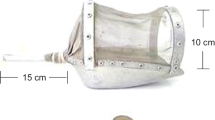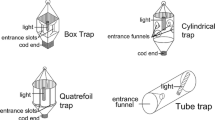Abstract
We compared the picture of aquatic invertebrate fauna given by three types of sampling methods: the corer as well as bottom and mid-water activity traps. The corer mainly caught benthic animals (89%), the most numerous groups of which were chironomids and sphaerids. Nekton was more abundant in activity traps (77% in bottom and 63% in mid-water), the most numerous groups were Cladocera and water mites. The size distributions in catch of the corer and the activity traps differed but there was no difference between the two types of activity traps. In activity traps, individuals of the smallest size class were most abundant, wheras animals of the second smallest size class were most numerous in the corer. We suggest that activity traps and the corer could be used as complementary methods to sample aquatic invertebrate communities.
Similar content being viewed by others
References
Armstrong, D. P. &; T. D. Nudds, 1985. Factors influencing invertebrate size distributions in prairie potholes and implications for coexisting duck species. Freshwat. Inv. Biol. 4: 41–47.
Bendell, B. E. &; D. K. McNicol, 1987. Fish predation, lake acidity and the composition of aquatic insect assemblage. Hydrobiologia 150: 193–202.
Brinkhurst, R. O., 1974. The Benthos of Lakes. MacMillan Press, London: 190 pp.
Brinkman, M. A. &; W. G. Duffy, 1996. Evaluation of four wetland aquatic invertebrate samplers and four sample sorting methods. J. Freshwat. Ecol. 11: 193–200.
Downing, J. A., 1984. Sampling the benthos of standing waters. In Downing, J. A. &; F. H. Rigler (eds), A Manual on Methods for the Assesment of Secondary Productivity in Fresh Waters. IBP Handbook No. 17. Blackwell Scientific Publications, Oxford. 2nd edn: 87–130.
Eadie, J. McA. &; A. Keast, 1982. Do goldeneye and perch compete for food? Oecologia 55: 225–230.
Elmberg, J., P. Nummi, H. Pöysä &; K. Sjöberg, 1992. Do introducing predators affect the reliability of catches in activity traps? Hydrobiologia 239: 187–193.
Elmberg, J., P. Nummi, H. Pöysä &; K. Sjöberg, 1993. Factors affecting species number and density of dabbling duck quilds in North Europe. Ecography 16: 251–260.
Eriksson, M. O. G., 1979. Competition between freshwater fish and goldeneyes Bucephala clangula (L.) for common prey. Oecologia 41: 99–107.
Hanson, J. M., E. E. Prepas &; W. C. Mackay, 1989. Size distribution of the macroinvertebrate community in a freshwater lake. Can. J. Fish. aquat. Sci. 46: 1510–1519.
Kenttämies, K., S. Haapaniemi, J. Hynynen, P. Joki-Heiskala &; J. Kämäri, 1985. Biological characteristics of small acidic lakes in southern Finland. Aqua Fenn. 15: 21–33.
Mackey, A. P., D. A. Cooling &; A. D. Berrie, 1984. An evaluation of sampling strategies for qualitative surveys of macro-invertebrates in rivers, using pond nets. J. appl. Ecol. 21: 515–534.
Meriläinen, J. J. &; J. Hynynen, 1990. Benthic invertebrates in relation to acidity in finnish forest lakes. In Kauppi, P., P. Anttila &; K. Kenttämies (eds), Acidification in Finland. Springer-Verlag, Berlin, Heidelberg: 1029–1043.
Mittelbach, G. G., 1981. Patterns of invertebrate size and abundance in aquatic habitats. Can. J. Fish. aquat. Sci. 38: 896–904.
Murkin, H. R., P. G. Abbott &; J. A. Kadlec, 1983. A comparison of activity traps and sweep nets for sampling nektonic invertebrates in wetlands. Freshwat. Inv. Biol. 2: 99–106.
Neckles, H. A., H. R. Murkin &; J. A. Cooper, 1990. Influences of seasonal flooding on macroinvertebrate abundance in wetland habitats. Freshwat. Biol. 23: 311–322.
Nudds, T. D. &; J. N. Bowlby, 1984. Predator-prey size relationships in North American dabbling ducks. Can. J. Zool. 62: 2002–2008.
Nummi, P., 1989. Simulated effects of the beaver on vegetation, invertebrates and ducks. Ann. Zool. fenn. 26: 43–52.
Nummi, P., 1993. Food relationships of sympatric mallard and green-winged teal. Can. J. Zool. 71: 49–55.
Nummi, P. &; H. Pöysä, 1993. Habitat association of ducks in different phases of the breeding season. Ecography 16: 319–328.
Nummi, P., J. Elmberg, H. Pöysä, &; K. Sjöberg, 1995. Occurence and density of mallard and green-winged teal in relation to prey size distribution and food abundance. Ann. Zool. fenn. 32: 385–390.
Pehrsson, O., 1984. Relationship of food to spatial and temporal breeding strategies of mallards in Sweden. J. Wildl. Mgmt 48: 322–339.
Pieczynski, E., 1961. The trap method of capturing water mites (Hydracarina). Ekol. pol. ser. B: 111-115.
Pöysä, H., M. Rask &; P. Nummi, 1994. Acidification and ecological interactions at higher trophic levels in small forest lakes: the perch and the common goldeneye. Ann. Zool. fenn. 31: 397–404.
Rask, M., 1986. The diet and diel feeding activity of perch, Perca fluviatilis L. in a small lake in southern Finland. Ann. Zool. fenn. 23: 49–57.
Rasmussen, J. B., 1993. Patterns in the size structure of littoral zone macroinvertebrate communities. Can. J. Fish. aquat. Sci. 50: 2192–2207.
Rodríquez, M. A. &; P. Magnan, 1993. Community structure of lacustrine macrobenthos: do taxon-based and size-based approaches yield similar insights? Can. J. Fish. aquat. Sci. 50: 800–815.
Wiederholm, T. &; L. Erikson, 1977. Benthos of an acid lake. Oikos 29: 261–267.
Wetzel, R. G., 1990. Land-water interfaces: metabolic and limnological regulators. Verh. int. Ver. Limnol. 24: 6–24.
Author information
Authors and Affiliations
Rights and permissions
About this article
Cite this article
Hyvönen, T., Nummi, P. Activity traps and the corer: complementary methods for sampling aquatic invertebrates. Hydrobiologia 432, 121–125 (2000). https://doi.org/10.1023/A:1004038707992
Issue Date:
DOI: https://doi.org/10.1023/A:1004038707992




